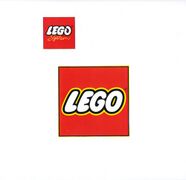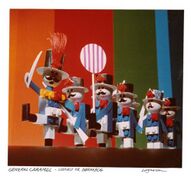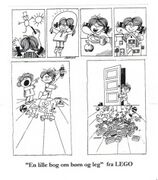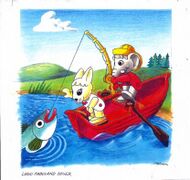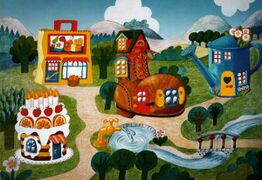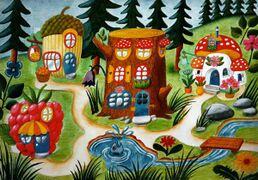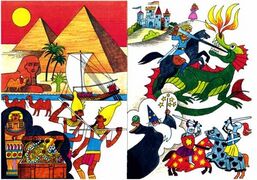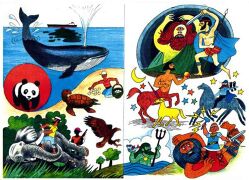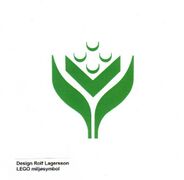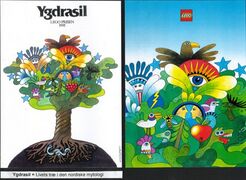Rolf Lagersson: Difference between revisions
No edit summary |
I don't really know where to place this paper doll parageaph. not in the normal biography, it's just here for now. maybe in a works/style section later? |
||
| Line 9: | Line 9: | ||
| death_place = Copenhagen, Denmark | | death_place = Copenhagen, Denmark | ||
| occupation = {{hlist|Artist|graphic designer}} | | occupation = {{hlist|Artist|graphic designer}} | ||
| years_active = | | years_active = 1948–2003 | ||
}} | }} | ||
| Line 15: | Line 15: | ||
== Biography == | == Biography == | ||
Rolf Lagerson was born on 8 January 1925 in [[Wikipedia:Malmö|Malmö]], [[Wikipedia:Skåne|Skåne]]. Lagerson initially studied architecture, but quit to work with a [[Wikipedia:Printer (publishing)|printer]] before deciding on a career in graphic art.<ref name="Amstutz"/> From 1946–1948 he studied in [[Wikipedia:Stockholm|Stockholm]] at | Rolf Lagerson was born on 8 January 1925 in [[Wikipedia:Malmö|Malmö]], [[Wikipedia:Skåne|Skåne]]. Lagerson initially studied architecture, but quit to work with a [[Wikipedia:Printer (publishing)|printer]] before deciding on a career in [[Wikipedia:Graphic arts|graphic art]].<ref name="Amstutz"/> From 1946–1948 he studied in [[Wikipedia:Stockholm|Stockholm]] at {{ill|Anders Beckman's|sv|Anders Beckman (konstnär)}} {{ill|school of advertising art|sv|Beckmans designhögskola}}{{efn|{{lang-sv|Anders Beckmans Reklamskola}}, renamed to Beckman College of Design ({{lang-sv|Beckmans Designhögskola}}) in 2003.<ref name="Beckmans"/>}} and the SGF school of typographical design.<ref name="Amstutz"/> For the following six years he worked at several advertising agencies: {{ill|Gumælius Annonsbyrå|sv|Gumaelius (reklambyrå)}} in Stockholm from 1948–1950, [[Wikipedia:Benton & Bowles|Benton & Bowles]] in [[Wikipedia:New York City|New York]] during 1951, and Wilh. Anderssons Annonsbyrå in Stockholm from 1951–1955.<ref name="Vem 1967"/><ref name="Foreign Advertising"/> In 1954 he began working as a [[Wikipedia:Freelancer|freelance]] artist, operating his own studio in Stockholm from 1955–1965.<ref name="Amstutz"/><ref name="Vem 1967"/> | ||
Lagerson became a founding member of SAFFT{{efn|Swedish Poster Design Association ({{lang-sv|Svenska Affischtecknare}}),<ref name="Aynsley"/> later ABCD.<ref name="Gyllenhoff"/>}} in 1949, a member of its board in 1954, and the society's president from 1957–1959.<ref name="Amstutz"/><ref name="Gyllenhoff"/> | Lagerson became a founding member of SAFFT{{efn|Swedish Poster Design Association ({{lang-sv|Svenska Affischtecknare}}),<ref name="Aynsley"/> later ABCD.<ref name="Gyllenhoff"/>}} in 1949, a member of its board in 1954, and the society's president from 1957–1959.<ref name="Amstutz"/><ref name="Gyllenhoff"/> | ||
In 1951 Lagerson began creating paper sculptures, inspired by the | In 1951 Lagerson began creating paper sculptures, studying from {{ill|Tadeusz Lipski's|pl|Tadeusz Lipski (grafik)}} 1947 book [https://archive.org/details/papersculpture0000tade ''Paper Sculpture'']. He later started designing paper dolls that could stand on their own, inspired by the [[Wikipedia:Stop motion|stop motion]] films of Czech animator [[Wikipedia:Jiří Trnka|Jiří Trnka]].<ref name="Angrave"/> Lagerson's dolls had [[Wikipedia:Ping-pong ball|ping-pong balls]] for heads, [[Wikipedia:Conical|conical]] paper bodies, and flat paper limbs. The dolls were customised with various paper details to create faces, uniforms, and headwear, and placed in sets also made of paper. The full sculptures were intended for use in colour photography. Lagerson's paper doll art was featured in [[Wikipedia:Bruce Angrave|Bruce Angrave's]] 1957 book ''Sculpture in Paper''; Angrave compared it to the works of [[Wikipedia:Walter Trier|Walter Trier]], "with the added excitement of a three-dimensional over-tone".<ref name="Angrave"/> | ||
<!-- | <!-- | ||
While in Sweden Lagerson married Birgitta "Gitt" Hammarberg, who was also a freelance artist. In 1965 Gitt and Rolf separated, and Rolf moved to [[Wikipedia:Copenhagen|Copenhagen]] in Denmark.<ref name="Come to Sweden"/> From this point forward, he started spelling his name as Lagersson.--> | While in Sweden Lagerson married Birgitta "Gitt" Hammarberg, who was also a freelance artist. In 1965 Gitt and Rolf separated, and Rolf moved to [[Wikipedia:Copenhagen|Copenhagen]] in Denmark.<ref name="Come to Sweden"/> From this point forward, he started spelling his name as Lagersson.--> | ||
Revision as of 07:46, 4 August 2024
Rolf Lagersson | |
|---|---|
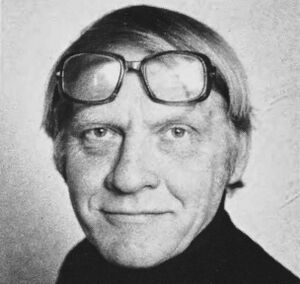 Lagersson in 1988 | |
| Born | Rolf Harald Lagerson 8 January 1925 Malmö, Skåne, Sweden |
| Died | 9 January 2006 (aged 81) Copenhagen, Denmark |
| Occupations |
|
| Years active | 1948–2003 |
Rolf Harald Lagersson (originally spelled Lagerson; 8 January 1925 – 9 January 2006)[1] was a Swedish artist and graphic designer.
Biography
Rolf Lagerson was born on 8 January 1925 in Malmö, Skåne. Lagerson initially studied architecture, but quit to work with a printer before deciding on a career in graphic art.[2] From 1946–1948 he studied in Stockholm at Anders Beckman's school of advertising art[a] and the SGF school of typographical design.[2] For the following six years he worked at several advertising agencies: Gumælius Annonsbyrå in Stockholm from 1948–1950, Benton & Bowles in New York during 1951, and Wilh. Anderssons Annonsbyrå in Stockholm from 1951–1955.[4][5] In 1954 he began working as a freelance artist, operating his own studio in Stockholm from 1955–1965.[2][4]
Lagerson became a founding member of SAFFT[b] in 1949, a member of its board in 1954, and the society's president from 1957–1959.[2][7]
In 1951 Lagerson began creating paper sculptures, studying from Tadeusz Lipski's 1947 book Paper Sculpture. He later started designing paper dolls that could stand on their own, inspired by the stop motion films of Czech animator Jiří Trnka.[8] Lagerson's dolls had ping-pong balls for heads, conical paper bodies, and flat paper limbs. The dolls were customised with various paper details to create faces, uniforms, and headwear, and placed in sets also made of paper. The full sculptures were intended for use in colour photography. Lagerson's paper doll art was featured in Bruce Angrave's 1957 book Sculpture in Paper; Angrave compared it to the works of Walter Trier, "with the added excitement of a three-dimensional over-tone".[8]
Select works
-
LEGO logo, 1972
-
"General Caramel", 1975
-
"En lille bog om børn og leg", 1980
-
Fabuland illustration, 1983
-
Duplo theme concept art, 1988
-
Duplo theme concept art, 1988
-
LEGO theme concept art, 1989
-
LEGO theme concept art, 1989
-
LEGO environmental symbol, 1995
-
Ygdrasil, 1995
-
LEGO packaging, 1971–1997
Notes
- ↑ Template:Lang-sv, renamed to Beckman College of Design (Template:Lang-sv) in 2003.[3]
- ↑ Swedish Poster Design Association (Template:Lang-sv),[6] later ABCD.[7]
References
- ↑ "About Rolf Lagersson". Rolf Lagersson Billedmager (in Danish). Archived from the original on 26 January 2024. Retrieved 31 July 2024.
- ↑ a b c d Amstutz, Walter, ed. (1962). Who's Who in Graphic Art. Zurich: Amstutz & Herdeg Graphis Press. p. 433.
- ↑ "Then and now". Beckmans. Archived from the original on 6 May 2024. Retrieved 2 August 2024.
- ↑ a b Lagerström, Sten, ed. (1966). "Lagerson, Rolf H". Vem är det: svensk biografisk handbok [Who is who: Swedish biographical handbook] (in Swedish) (1967 ed.). Stockholm: Norstedt & Söner. p. 510. Archived from the original on 3 August 2024.
- ↑ A Directory of Foreign Advertising Agencies and Marketing Research Organizations. Washington, D.C.: U.S. Government Printing Office. April 1959. p. 109. OCLC 1155970.
- ↑ Aynsley, Jeremy. "A Century of Graphic Design". London: Mitchell Beazley. p. 128. ISBN 1-84000-348-0.
- ↑ a b c Gyllenhoff, Carl (21 January 2006). "Rolf Lagerson". Dagens Nyheter. Stockholm. Off-site copy available here.
- ↑ a b Angrave, Bruce (1957). Sculpture in Paper. London: The Studio Ltd. pp. 86–87.
- ↑ Bernsen, Jens; Capetillo, Birgitta, eds. (1988). Profession: Designer. Copenhagen: Dansk Design Center. pp. 90–91. ISBN 87-87385-40-6.
- ↑ Vagland, Jens; Tjelder, Michael; Londen, Magnus (2015). "Rolf Lagerson". Come to Sweden (in Swedish). Come to Sweden Publishing AB. ISBN 978-91-637-8312-8. Archived from the original on 26 January 2024.
- ↑ "Rolf Lagersson". Danske selskaber [Danish companies] (in Danish). Archived from the original on 2024-07-31.
- ↑ Dickson, Thomas (2006). "Grafisk design". Dansk design. Copenhagen: Gyldendal. p. 476. ISBN 978-87-02-07768-1.
Sløjfens facon gav i midten af 1970'eme inspiration til det logo, som Kræftens Bekæmpelse har i dag. Det blev tegnet af grafikeren Rolf Lagersson og tegnestuen Plan Design, der forenklede det gamle mærke til et mere abstrakt symbol for foreningen.
- ↑ "LEGO". Danish Logo Preservation Society. December 2017. Archived from the original on 2018-02-21.
External links
- Official website (requires flash)
- Rolf Lagerson at Swedish Wikipedia
